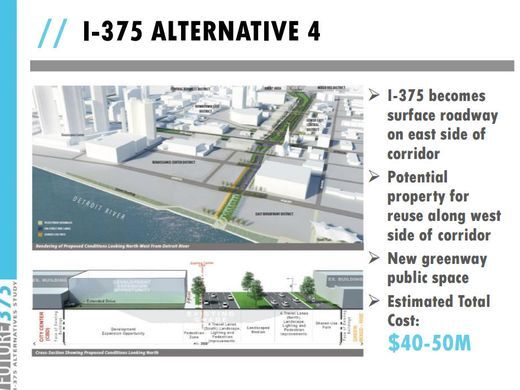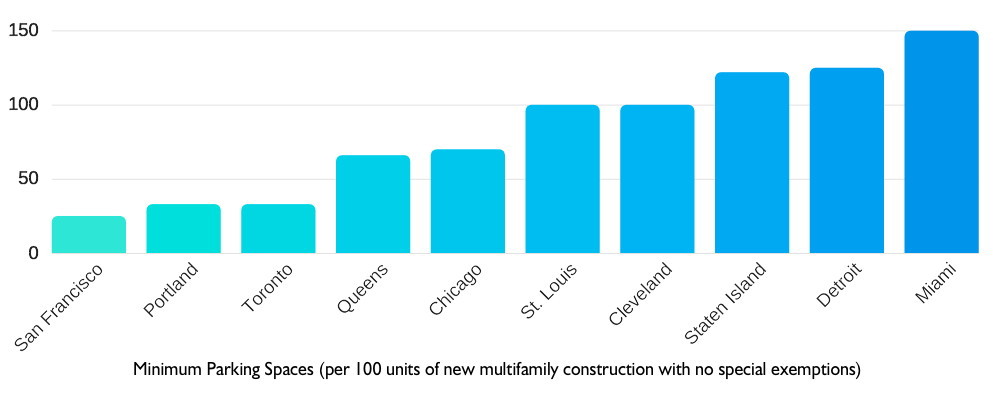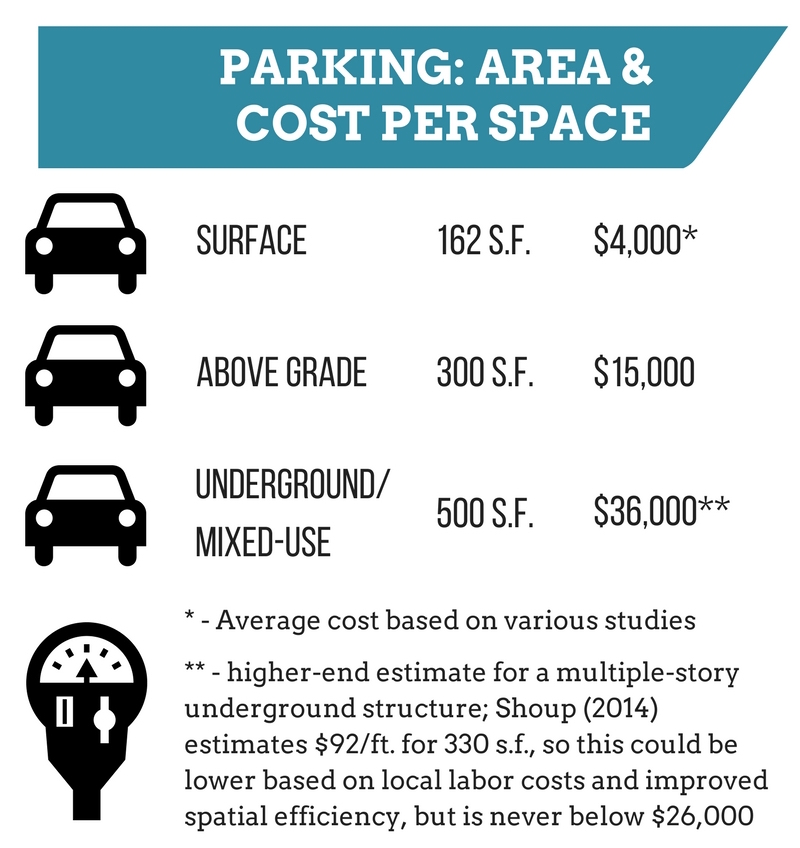Detroit Park City: Unlearning the Motor City’s Parking Culture
At a recent MDOT planning meeting hosted at the illustrious Shed 5 in Detroit’s Eastern Market, I again found myself thinking, while poring over drawings for proposals to essentially eliminate the spur of I-375 that extends from the I-75/I-75 junction, how much space in our city is taken up by infrastructure whose sole purpose is to move– or store- vehicles.

Unfortunately, it is currently logistically and politically impossible to get rid of our freeways. I suspect that they will eventually be retooled in some future generation, but in the meantime, it will be a tough sell to dehighwayize even I-375, a not terribly useful spur which occupies a full 30 acres of prime real estate between Jefferson Avenue downtown and the I-75 interchange alone. The proposal to replace it with a large, surface level boulevard, reclaiming enough space to build, well, millions of square feet of cool stuff that can generate tax revenue, will probably be shot down by a Transportation Engineer Who Knew Better, but I hope I’m wrong.
Downtown parking, on the other hand, is readily addressed, because, like highways, most parking in older urban areas, especially in the cores of the industrial Midwestern cities, was developed from demolition rather than greenfield space. And parking predictably dominates most public conversations about development. The old NIMBYist adage, “But where will we park?” feels much like in the series Downton Abbey when, amid speculation that the large country manor could be partially converted into a hospital for wounded veterans in the Great War, Cora Crawley asks plaintively, “But where will we sit?” The viewer is sitting there, like, “I don’t know, your ladyship– you’ve got a giant house, maybe you could find space in one of the other 247 rooms?” Where will we park? I don’t know, there are about 135 square miles of city to choose from, maybe somewhere that will necessitate walking 45 feet?
I hypothesized that the spirit of Jane Jacobs herself began to haunt Southwest Housing Solutions’ offices at Lithuanian Hall on Vernor Highway when they won an innovation grant to renovate a parking lot, or when they demolished a salvageable vacant structure across the street because their mostly suburban workforce needed more parking (the quarter-acre of existing lots and thousand feet of street parking weren’t enough). Even The Man Himself has gotten into the parking game.
So I decided it might be fun to put together a project I call Detroit Park City (referencing, of course, the 1976 Kiss song, in which I can only assume that Paul Stanley suggests that you’ve gotta lose your mind in Detroit Rock City because of the unholy supremacy of automotive transport) to identify a long list of parking lots in our city, and target each one for a proposed redevelopment project, comparing costs, revenue figures, ownership data, and, chiefly, space– the built and the yet unbuilt. So, I’m not going to actually design a fancy rendering because I’m not that clever, but I’ll design a basic massing. I’m shooting for producing one project a week for a year.

ASSUMPTION: PARKING DOES NOT GROW ON TREES
I am basing my foundations here on research I started for a January 2017 memo I presented to Southwest Solutions’ management outlining the high cost of free parking and why the company should implement commuter incentives for cyclists and pedestrians. In it, I reviewed research from planning organizations and experts who argued in favor of a comprehensive reëvaluation of the notion of “free” parking– namely, how free parking causes a lot of problems and costs a lot of money. This has been explored at length by planners Jeff Speck, Donald Shoup, and others, and it has also been written about extensively in urban planning media and transportation advocacy by the likes of Streetsblog, CityLab, and others.
The major cultural assumption, anathema to the Michigan F250 Super Duty State of Mind, is that cities might be better served by buildings than by parking. My evidence for this is that Detroit’s real estate prices have gone through the roof following a general recognition that Detroit Doesn’t Suck, and that there is a tight relationship between density and amenities– density allows amenities and thrives with amenities (see Rappaport, 2008, in Regional Science and Urban Economics, and others). There are more parking spaces than there are human beings in this great nation, and that’s pretty weird.
For the purposes of this study, the major political assumption is that we will be able to negotiate around parking minimums or avoid them altogether. Detroit’s parking minimum of 1.25 spaces per unit puts the city basically at the highest end of any major American city, although the city’s rockstar planning leadership of Steve Lewis and Maurice Cox suggests that there might be room to negotiate based on the drive toward innovation.

Every city’s approach to parking minimums is completely different, and many are changing; restrictive, convoluted zoning codes are usually designed to make sure spatially bountiful districts have more parking requirements, as in Toronto or San Francisco, while some approaches encourage high density through things like micro-apartments (Chicago). Manhattan’s parking situation, where the city has since 1982 imposed maximums rather than minimums, is a mess for developers to navigate, but the result, CityLab’s Eric Jaffe reports, is an average of five spaces per 100 units (realistically with the maximums versus minimums it’s about 20, but Manhattan is singular– as they are well aware).
Parking minimums also just don’t seem to work well in practice, so they are being reduced (as in the case of outlier Miami’s 1.5 spaces per unit) or sometimes completely abolished in high-density districts, including St. Louis and many other cities.
I am not a data wonk, so I wouldn’t know how to get at the data behind the number of off-street surface parking or parking spaces in structures in the city of Detroit, but one thing I do know is that the city’s extremely low density, well under 5,000 people per square mile, doesn’t really increase appreciably downtown, and that’s evidenced by the sea of parking that surrounds chiefly the Grand River and East Jefferson corridors.
What would be interesting and would deliver, I imagine, some completely unsurprising results, is to overlay an analysis of the parking minimums in these cities with an analysis of density of these cities and per capita income or some other measure of economic prosperity. Donald Shoup’s most salient criticism is, I think, that we are spending sometimes up to several times more on a parking space than a car is actually worth. The economic drain is pronounced and is an excellent case for building stuff that serves people, not cars, especially in a city as impoverished as Detroit where one might spend 75% of their housing payment on utility bills and might spend that same 75% on car insurance.
MEASURING THE EFFICIENCY– OR LACK THEREOF- OF OFF-STREET PARKING
Exploring the efficiency of parking structures versus parking lots, the former is clearly less efficient from a ratio of “square feet of parking spaces” to “square feet of other stuff.” Experts suggest that as much as 59% of the space in an above-ground parking structure or up to 68% of the space in underground garages is dedicated to space other than parking spaces, i.e. driving lanes, ramps, pedestrian paths, or office or other retail space (I actually go to yoga in a parking garage, which is probably figuring into the construction costs), making both of these far more expensive and far less efficient per space. So, they make sense for (literally) sky-high demand, which I will illustrate, even when a space in a multiple-story underground garage can be as high as $36,000 (extreme end, but worth noting). We have generally come down on the side of angle parking being more efficient than 90° parking— it saves space, for the most part, even though it requires some sacrifices.
If we take an operational efficiency approach, we are left with the tragic reality that there is no real frontier of efficiency in a model that necessitates wasted space. I hope to collect data that demonstrates what the effective frontier of efficiency actually is, and I am going to hypothesize that it is pretty bad for surface lots.
TOWARD BETTER ALTERNATIVES
Since I’m marginally– but comfortably- more of a business mind set than an academic one, I’m looking at this topic of land use planning from the standpoint of asking, “what could we build here?” as opposed to abstractly analyzing land use in the aggregate. I want to explore the horizon of tradeoffs between building one thing versus another, and graphically illustrate what this looks like for the purpose of site redevelopment. I currently have 26 data points and variables for each site, ranging from the State Equalized Value (property tax assessment), to the observed, theoretical minimum, and theoretical maximum number of parking spaces, to hypothetical numbers of units that could be built on a space, and I will update this as the list changes based on my observations.
I am going to select sites relatively randomly but take into account sites with common ownership in locations where new construction could bring substantial value to the surrounding area. My only specific selection criterion is that the sites be in the city of Detroit, although that may change if I get stuck in Windsor for a lazy afternoon. 🙂
My first post, a review of the lots surrounding the ancient and honorable Mexican Village restaurant in Corktown/Southwest, is coming, so stay tuned.
Further reading:
Chrest, Anthony, et al. “Parking Structures: Planning, Design, Construction, Maintenance, and Repair.” 2001.
Shoup, Donald. “The High Cost of Free Parking.” APA Planners Press, 2005.
Speck, Jeff. “Walkable City: How Downtown Can Save America, One Step at a Time.” North Point Press, 2012.


